We spent the second half of January 2013 in the state of Oaxaca, perhaps the culturally and botanically richest part of Mexico. For all of our efforts we barely scraped the surface of what Oaxaca has to offer; as superficial as the aromas from a stranger’s kitchen.
We were there with a small group visiting various practitioners of the traditional arts of weaving, dyeing and silk production. I was increasingly interested in the main events, but took every opportunity to look for birds.
The birds I saw fell easily into two groups: the familiar and the brand new. It was helpful for me that fully one third of species seen were old friends, either because they have a continent-wide distribution or because they’re neo-tropical migrants who head north to breed. I won’t dwell on the familiar ones but, for the record, they include Osprey, Brown Creeper, Orchard Oriole, Blue-gray Gnatcatcher and Wilson’s Warbler.
Seabirds and shoreline:
Our first day included a day-long excursion along the rocky Pacific coast to see how Mixtec Indians have, for centuries, milked a purple dye called murex from the mollusk Purpura panza. Collected at low tide the shellfish will squirt a stream of greenish liquid when its foot is pressed; it’s a defensive strategy in much the same way that a squid or octopus ejects a cloud of ink. The aim is to direct the dribble of juice over raw cotton yarn and, once milked, the mollusk is returned to its watery hiding place unharmed, if a little annoyed; it’s a truly renewable resource. When laid out and exposed to the air and sun, the dyed skein of cotton soon turns a glorious royal purple.
On our boat trip along the coast, we were accompanied by Magnificent Frigatebirds soaring and wheeling high above. Brown Pelicans sat like sentries on the rocks, watching and sometimes diving for fish. We saw small flotillas of Red-necked Phalaropes bobbing in the swells, one of them lost it’s life in an ambush by a Peregrine Falcon which came from afar, picked its meal and returned to its cliff-side perch; such eyesight! On return to port there was a line of Royal Terns and Elegant Terns on the cruise ship dock and a Brown Booby flew overhead.
A Guided Tour
Through the Birdingpal website I engaged Eric Antonio Martinez to take me out for a day of birding while my wife and others enjoyed weaving-related discoveries. Eric, whose knowledge of birds is encyclopedic, had spent most of 2008 as a field assistant at Long Point Bird Observatory so his English is excellent.
We were in the deep south of Mexico on the sea level plains around Salina Cruz and Tehuantepec, quite close to Guatemala. The area is known for high winds, but on this day an uncharacteristic ceasless, gale force wind from the north made it very difficult. For a winter visitor it was nevertheless a rewarding day.
Two stunning finds were several Rose-breasted or Rosita’s Buntings and a Lesser Ground Cuckoo (see blog entry). But there was much more. We started long before dawn and just as it was getting light, Eric whistled for and called to within a few feet of us, a Ferruginous Pygmy Owl which, unlike other owls, is diurnal. White-lored Gnatcatchers hung around us in the mesquite scrub and a small group of White-breasted Magpie Jays wandered among the treetops. I had no hope of identifying any of the hummingbirds we saw: Doubleday’s Hummingbird, Beautiful Hummingbird or Plain-capped Starlet, they’re small, constantly zipping around and all look very much alike to a novice.
A Stripe-backed Oriole, Ash-throated Flycatcher, Banded Wren, Stripe-headed Sparrows and Scissor-tailed Flycatchers all made visual sense, but I needed Eric to put names to a high-flying, immature White-tailed Hawk (which at this stage in its life I would have tagged as Red-tailed), a Short-tailed Hawk and a fleeting glimpse of a Laughing Falcon.
In the ripping wind we scanned a couple of bodies of water and found a Northern Jacana and a Cinnamon Teal, plus hundreds of Blue-winged Teal hunkered down in the lee of a bank of reeds.
Inland and in the high valleys.
The Sierra Madre comprises much of the heart of the state of Oaxaca. They are folded mountains, formed by the collision of the Earth’s Cocos and Caribbean Plates. Mighty stuff, far beyond the scope of this blog, but not to be trifled with as Mexico’s many active volcanoes bear witness. The significance however is that much of Oaxaca is rugged and untamed and is far above sea-level. By the time we reached the great high valley where the City of Oaxaca is located, we were 1,550 metres, or one mile, above sea level; I could feel tightness in my lungs.
The mountains were cloaked in pines and oaks and their eastern slopes were moister than the western; it had a noticeable effect on plant communities and presumably animals too. The Oaxaca valley floor was generally dry and scrubby where not farmed.
At one of our stops I found my way to a small tree-lined creek that had been dammed to form successive ponds and that attracted quite a bit of bird life. Around it I found an American Pipit, Black Phoebe, Gray-breasted Woodpeckers and many Vermillion Flycatchers and Wilson’s Warblers. The farmland, cacti and mesquite nearby were home to: Loggerhead Shrikes, Blue Grosbeaks, Curve-billed Thrashers, and Boucard’s Wrens. The Emberizidae family was there too, represented by Blue Grosbeaks, Lark Sparrows and loads of White-throated Towhees.
Birds of Prey
Mexico counts at least 10 butoes in its avifauna, of them I knowingly saw perhaps four: Short-tailed Hawk, White-tailed Hawk, Red-tailed Hawk and Common Black Hawk. My falcon tally was just three: American Kestrel, two or three Laughing Falcons and our first day’s, phalarope-hunting Peregrine Falcon. The Laughing Falcon is a black-backed, pale-below bird with a black mask. It flies with the heft and purpose of an accipiter and is appreciated for its dietary preference for snakes. I looked for but saw no sign of snakes, and people I asked seemed to dismiss them as so uncommon as to be of little concern; unless you should be bitten of course.
A near-falcon is the Crested Caracara, Mexico’s official bird. It popped up several times, usually taking me by surprise, and seemed to be widespread.
While not strictly birds of prey it would be an oversight not to mention the ever-present Black and Turkey Vultures. And I must not forget the Ospreys seen along the coast, a magnificent bird found on every continent except, for good reason, Antarctica.
Odds and ends.
Doves: Inca, White-winged, Mourning and Common Ground Doves are found apparently everywhere and, according to my notes, Eric pointed out a White-tipped Dove on my guided tour.
Tyrant Flycatchers: It was relatively easy to identify Great Kiskadees, Ash-throated Flycatchers, Tropical Kingbirds, Cassin’s Kingbirds, Vermillion Flycatcher, Dusky-capped Flycatchers and Scissor-tailed Flycatchers. But I confess to having seen, but not identified, a few empidonax flycatchers; those are for another day.
Thrushes. Our familiar American Robin has Mexican cousins: the White-throated and the Rufous-backed Thrushes are so obviously near relatives that in poor light they’d be hard to tell apart.
Icterids. There were lots, everything from a bunch of dreary Brown-headed Cowbirds, through blazing orange Bullocks, Streak-backed and Hooded Orioles. I found a single Eastern Meadowlark singing after an all-too-brief rain and flocks of Orchard Orioles had me puzzled for a while. Great-tailed Grackles kept up a constant cacophony of squawks, whistles and rattles in competition with equally vocal Yellow-winged Caiques.
Good reading.
I carried Birds of Mexico and Central America by Ber Van Perlo, published by Princeton University Press. It was indispensible, but I had taken the time ahead to make little marks beside any species likely to be within range. Without the homework the task would have been very daunting; there’s about 35 generally green-all-over parrots illustrated, but only 9 or 10 are found in Oaxaca.
I took along the National Geographic Field Guide to the Birds of North America, its detail and comparisons were helpful many times.
The birder’s bible in Mexico is A Guide to the Birds of Mexico and Northern Central America; 850 pages of research and descriptions. Not something to lug along with you in the field but I have ordered it for next time. There will be a next time.

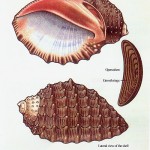


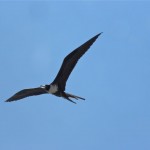

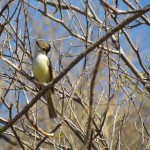
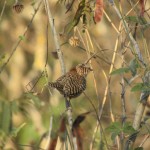
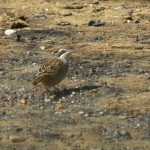
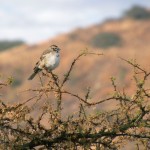
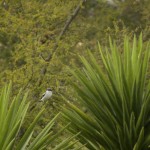
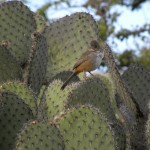
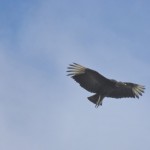
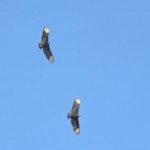
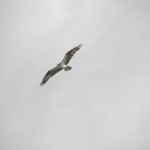
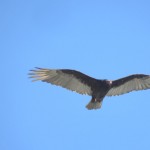
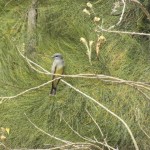
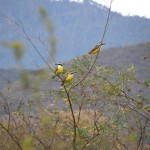
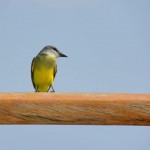
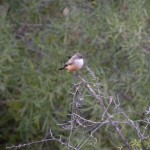
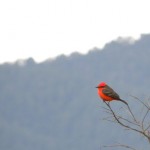
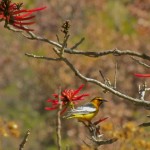
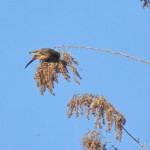
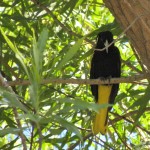
Great summary Peter, sounds like you are a convert to the wonders of Mexico. It is an amazing and divest country and one always finds something to discover.
Peter, we always enjoy your writings. Mexico seems like a dream come true to a birding novice like me. Terrific pictures, good descriptions and what great colors. Looking forward to seeing you at Ruthven.
I have been taking pictures in and around Huautlco for the past 5 years. If interested you can see some of the photos on a couple of websites I keep: http://www.oaxacawildlife.org and http://www.birdsofhuatulco.com
Huatulco is certainly a special place!
HiJon
Just had a look at your bird photographs – the second lot from Huatulco. Your third photo is not a Bush-tanager but is a Rusty-margined Flycatcher, same kind of size and jizz as Social Flycatcher but the rusty margins are very evident in your photo. Have been birding in South America 10 times and in Costa Rica one trip, so am familiar with this species. Probably I am not the first to tell you, so if so apologies!
Thank you for the help in identification! I am grateful for any help I can get with the website. The diversity is incredible and just have not had a lot of time to research what I get a photo of. I enjoy the photography and take pictures of everything I see of interest on my walks in the Huautlco area. I am on may way there at the moment and am looking forward to taking more pictures. Thanks again.
Maybe a warbler? I would like to know what it is.
Maybe a Red-faced Warbler.
In Oaxaca (Ciudad) I saw large raptor that immediately struck me as eagle-sized. Overall the bird was somewhat mottled, dark gray-brown. The notable markings were white at the base of the tail and diagonal bands of white toward the ends of the wings. I think that these were visible from the top, but am uncertain about that. Wikipedia lists the southern extent of the golden eagle’s range as Guadalajara. Do you know whether these birds are found in Oaxaca?
That does sound like a Golden Eagle.
Their range is through N to Central Mexico but not so much in Oaxaca. But could be…
Have you been to Oaxaca recently? Just returned from 10 days in Oaxaca City and trips to surrounding villages. Was struck by the near absence of birds (as I have been recently in Korea, Italy and Spain). Also noted just 2 mosquitos, 1 bee and 1 cockroach. Am I making too huge a leap connecting the absence of insects (poisons?) To the scarcity of birds?
I haven’t been to Oaxaca since 2013 when I loaded the posts. I don’t recall Oaxaca City as particularly birdy but did see lots out of the city, elsewhere in the state.
The decline of insects is in my view one of the best-kept most-foreboding secrets. I’m seeing it, you’re seeing it, others report it, and perhaps the majority of people celebrate it b/c they associate insects with discomfort. They could well be the underpinning of life on Earth. I don’t think you’re making a huge leap.
i sow golden eagle in Oaxaca just above Mitla archeological cite. At Santa Maria Del Tule, a goshawk size raptor caught the pigeon just above my had and fly with it. Raptor had light orange colored breast with stripes and rad tale. i could not identify it. Any ideas, what it could be?
I don’t know anything with an orange breast and red tail but maybe Harris’ Hawk, Red Shouldered Hawk or Red-tailed Hawk. But I don’t really know Mexican raptors.